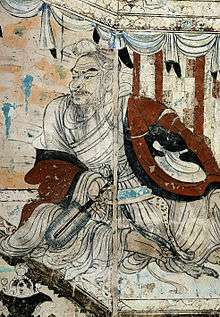Vimalakirti
Vimalakīrti (Sanskrit: विमल vimala "stainless, undefiled" + कीर्ति kīrti "fame, glory, reputation") is the central figure in the Vimalakirti Sutra,[1] which presents him as the ideal Mahayana Buddhist upāsaka ("lay practitioner")[2] and a contemporary of Gautama Buddha (6th to 5th century BCE).[1] There is no mention of him in Buddhist texts until after Nāgārjuna (1st century BCE to 2nd century CE) revived Mahayana Buddhism in India.[3] The Mahayana Vimalakirti Sutra also spoke of the city of Vaisali as where the lay Licchavi bodhisattva Vimalakirti was residing.[4]

As a Zen Patriarch
The Vimalakīrti Nirdeśa Sūtra characterizes Vimalakīrti as a wealthy patron of Gautama Buddha.[5] Unlike many other figures of the Mahayana literature, such as Avalokiteśvara, he is generally taken to be a historical figure like Gautama Buddha, rather than mythic or legendary, and as such Vimalakīrti is not commonly venerated on altars or in tantric rituals,[6] but as a prehistoric zen, i.e., chan preacher.
See also
References
- "The Vimalakirti Sutra: The Dharma-Door of Nonduality". About.com. Retrieved April 17, 2013.
- "Vimalakirti and the Doctrine of Nonduality". Metropolitan Museum of Art. Retrieved April 17, 2013.
- Thurman, Robert (2000). The Holy Teaching of Vimalakirti: A Mahayana Scripture. Pennsylvania State University Press. p. ix. ISBN 0271012099.
- Thurman, Robert. "VIMALAKIRTI NIRDESA SUTRA". Retrieved 17 September 2014.
- Baroni, Helen Josephine (2002). The Illustrated Encyclopedia of Zen Buddhism. The Rosen Publishing Group. p. 369. ISBN 9780823922406.
- Leighton, Taigen Dan. "Boddhisattvas of Compassion Lesson 8: Vimalakirti". Ashoka: the eDharma learning center. DharmaNet International. Retrieved 22 August 2014.